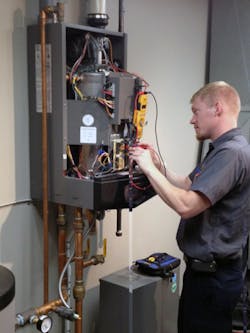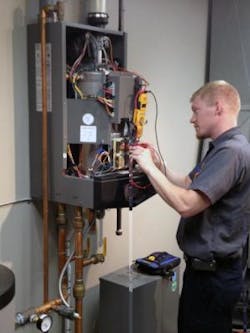While none of us want to think about it, the start of heating season is only a few months away. Now’s the time to brush up on your boiler tune-up skills and make sure your technicians are properly trained to ensure peak system operation. It’s important to know what type of system the boiler is servicing to make sure you are setting up the boiler properly.
Here are some basic inspection points for hot water and steam boilers.
Hot Water Boiler Tune-up
1. Turn heat on at thermostat to make sure everything works before you touch the boiler.
2. Clean gas section of boiler (including burners, pilot, flame sensor, etc).
3. Check igniter.
4. Clean condensate traps and drains on high efficiency boilers.
5. Inspect exhaust and combustion air piping.
6. Inspect (and test is applicable) safety roll-out switches and temperature limits.
7. Test low water cut-offs and pressure switches.
8. Test relief valves and make sure that the proper relief valve is installed for the system.
9. Test and inspect pressure reducing valves.
10. Expansion Tank – drop system pressure and check tank pressure, adjust as required for system.
11. Compression Tank- isolate from system and drain tank to proper level (if possible). Be careful not to create a vacuum in the tank if the proper fitting are not installed on the tank for recharging.
12. Inspect circulator pump.
a. Wet-rotor style – inspect flanges for leaks and check wiring connections.
b. Three-piece – oil bearing and motor (if applicable), inspection motor mounts and coupler, inspect flanges for leaks, check wiring connections.
13. Check gas pressures and perform combustion test to ensure proper operation on the gas side of the equipment.
Steam Boiler Tune-up
1. Turn heat on at thermostat to make sure everything works before you touch the boiler.
2. Clean gas section of boiler (including burners, pilot, flame sensor, etc).
3. Check igniter.
4. Inspect flue piping .
5. Inspect (and test is applicable) safety roll-out switches.
6. Test low water cut-offs and automatic water feeders.
7. Test Pressuretrols and Vaporstats. Look to make sure that the system the boiler is connected to has the proper pressure control. We find many times that a system that should be controlled by a Vaporstat only has a Pressuretrol . This will make a significant difference in the operation of the system.
8. Pull apart and clean pigtails below all pressure controls. Just because you test the switching mechanism on a pressure control does not mean it will work during normal system operation. We find plugged pigtails all the time.
9. Clean sight glass and replace washers every year. You need to see what the water level in the boiler is. Do not skip this step!
10. Test relief valves and make sure that the proper relief valve is installed for the system.
11. Inspect system main line vents. If the system can’t get rid of air effectively it will not work properly. Also you want to make sure they are shutting off to steam.
12. Check gas pressures and perform combustion test to ensure proper operation on the gas side of the equipment.
When performing a tune-up on a hydronic system, you should also include a quick check of the system’s heat emitters. These could be cast iron radiators, convectors, fin tube baseboard, in-floor radiant and many others.
Remember that a tune-up on equipment is only part of the system. You need to do at least a visual inspection of the piping and heating system to look for leaks or anything out of the ordinary. Sometimes we find that a homeowner has done some remodeling and the general contractor had his guy relocate the heating lines. More times than not this results in us having to redo the work because they do not understand how steam systems operate and the importance for proper piping.
Ask Homeowner About System Performance
Ask the homeowner questions about how the system operates, hot and cold spots, etc. Steam systems tend to be very finicky in mild weather. Once the outdoor temperatures drop below 40 and stay there they will heat more evenly. Venting of air in a steam system is critical. Proper regulation of venting will ensure a comfortable, evenly heated home. This will also improve system efficiency.
For hot water systems, you may be able to adjust the operating water temperature based on what type of heat emitter is present in the home. You may also be able to offer outdoor weather reset controls to increase system efficiency.
Operating Pressure Control
One of the most common problems I find with steam systems has to do with the operating pressure control switch. All new steam boilers come with a Pressuretrol operating control that only allows you to adjust the pressure settings in pounds. A quick look at the radiators will let you know if you have a system that requires a Vaporstat operating control. Vapor steam systems operate properly on less than one pound per square inch of steam pressure. If this is exceeded, the system may heat very unevenly and cost more to operate.
I remember finding this exact situation in a home that we had just started to take care of. We recommended and installed the new Vaporstat control. After that winter the customer called to tell us that was the most comfortable her house had been since they had the new boiler installed. In fact, her favorite sitting room, which was once cold, was now the most comfortable spot in the house.
Brian Stack is president, Stack Heating & Cooling, Avon, OH.

